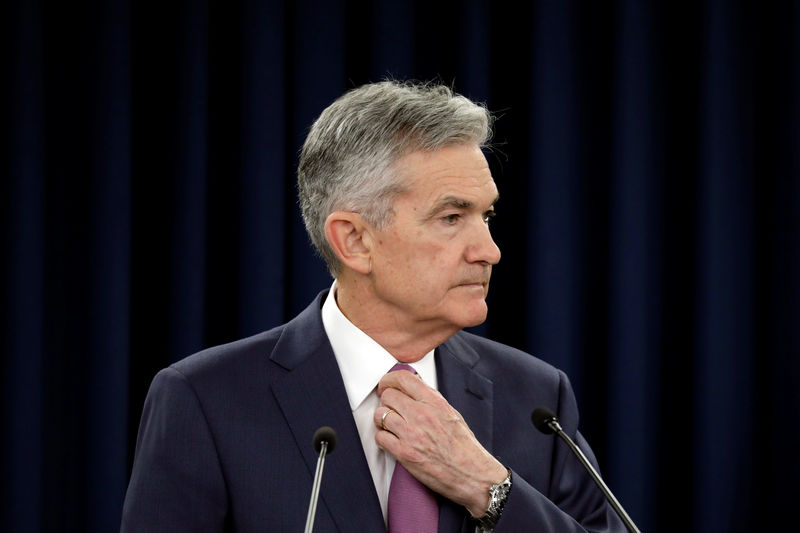By Geoffrey Smith
Investing.com -- The sell-off in U.S. bonds reverberates through global markets, but Wall Street looks set for a modest bounce at the open. Non-farm payrolls are expected to have picked up smartly from January’s level; OPEC’s decision not to raise output send oil rallying and analysts scrambling to raise their forecasts. And China has set its GDP growth target for this year lower than many had expected. Here’s what you need to know in financial markets on Friday, March 5th.
1. Powell comments weigh on global markets
The sell-off in U.S. bonds triggered by Federal Reserve Chairman Jerome Powell’s comments in a speech on Thursday reverberated around global markets, although European stocks in particular staged a comeback after a weak opening. The Dollar Index, meanwhile, hit its highest since November.
Powell had again reiterated that the Fed would be in no hurry to tighten monetary policy until there has been substantial progress in reducing unemployment. His comments sent the 10-year Treasury yield as high as 1.55% and the 30-Year as high as 2.35%. Both retraced lower later, but the rise in rates is a clear danger to the trend for mortgage refinancing. 30-Year mortgage rates topped 3% on Thursday.
Powell indicated that the Fed would remain unfazed by rising yields as long as markets remained ‘orderly’. While the rush to short longer-dated Treasuries has created pockets of stress in the repo market, that is still – so far – the case.
2. China’s low growth target
China issued a new growth target for 2021 clearly below most expectations.
At the annual National People’s Congress, a meeting that sets economic priorities for the year, Premier Li Keqiang outlined an aim of 6% gross domestic product growth. That compares to a forecast of 7.9% from the International Monetary Fund in its latest World Economic Outlook.
The figures suggest that Beijing wants to withdraw some of the powerful stimulus measures it put in place last year, mindful of the sharp rise in public and private debt over the last 12 months. The country’s top banking supervisor only last week warned of bubbles in various markets, including for domestic real estate.
Base metals prices, which had fallen sharply on Thursday, recovered overnight.
3 Stocks set to open with a modest bounce. Broadcom, Gap, Costco eyed
U.S. stocks are set to open modestly higher after fresh losses on Thursday, but traders will be wary of pushing too hard at the open: the pattern this week has been for bright openings to run into heavy selling almost immediately.
By 6:40 AM ET (1140 GMT), Dow Jones futures were up 81 points, or 0.3%, while S&P 500 futures were up 0.2%. NASDAQ Futures, which have borne the brunt of this week’s selling and finished on Thursday at their lowest in nearly three months, were up 0.1%.
Stocks likely to be in focus later include Broadcom (NASDAQ:AVGO), Costco (NASDAQ:COST) and Gap (NYSE:GPS), all of which beat expectations with their quarterly earnings reports after the bell on Thursday.
4. Payroll growth set to strengthen again
Action in stocks and bonds seems likely to remain muted at least until 8:30 AM ET, when the monthly labor market report will be released.
Analysts expect the U.S. economy to have added 182,000 nonfarm jobs in the month through the middle of February, which would represent a second straight monthly improvement in hiring. However, analysts will also be watching what happens to the labor force participation rate, which fell to its lowest since June in January as discouraged workers stopped looking for work.
The numbers come a day after a small rise in weekly jobless claims on Thursday, which nonetheless masked a drop of 1 million people in the overall number of those claiming unemployment-related benefits.
Also due at the same time are U.S. trade balance figures for February.
5. Oil extends gains after OPEC+ surprise
Crude oil prices surged to their highest since January 2020 as analysts rushed to upgrade their price forecasts in the wake of the surprising decision by OPEC and its allies to keep output effectively unchanged in April. Many had expected an increase of 1.5 million barrels a day or more.
The decision means that drawdowns in global stockpiles are likely to accelerate if the northern hemisphere’s economy can continue to reopen after the winter surge in Covid-19. Citigroup (NYSE:C) now expects Brent prices to hit $70 a barrel by the end of the month, while Goldman Sachs (NYSE:GS) analysts expect to see it at $80 in the third quarter of the year.
The news has also sustained a strong bid for oil and gas stocks, with a handful of European majors and oilfield services stocks all hitting 13-month highs in the European morning.
The decision will add a degree of spice to Baker Hughes’ rig count data later, given that the OPEC decision implies that U.S. shale will not be reviving any time soon.
